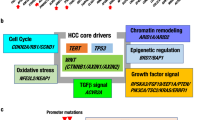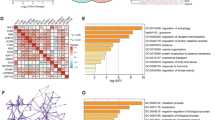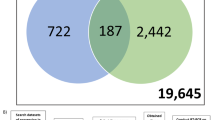Abstract
To disclose genetic mechanisms involved in development or progression of hepatocellular carcinoma (HCC), we used a genome-wide cDNA microarray consisting of 8,448 genes to compare gene-expression profiles among 12 liver-cirrhosis nodules (LCNs) and five specimens of HCC excised from a single patient and carefully prepared by laser-capture microdissection (LCM). The expression patterns enabled us to identify 72 genes that were frequently upregulated and 57 that were downregulated specifically in the LCN specimens as compared to the HCCs. We also documented upregulation of 31 genes and downregulation of seven others in both HCC and LCN tissues. Several types of intracellular kinase, including receptor-type kinase, were upregulated in LCNs. Expression patterns of HCCs and LCNs generally represented two genetically distinct groups when subjected to a hierarchical clustering analysis, although expression profiles of two of the LCNs resembled the HCC pattern. Analysis of allelic losses at microsatellite loci revealed that LCNs showed frequent loss of heterozygosity (LOH) (33%) in chromosomal regions 6q and 22q; over half of the LCNs had lost an allele for at least one of the 28 loci examined. The presence of early genetic changes among LCNs, with additional genetic changes occurring during formation of HCCs, suggests that hepatocellular carcinogenesis follows the multistep model established for colon cancers and that some LCNs may be precancerous lesions.
Similar content being viewed by others
Log in or create a free account to read this content
Gain free access to this article, as well as selected content from this journal and more on nature.com
or
References
Bonner RF, Emmert-Buck M, Clole K, Pohida T, Chuaqui R, Goldstein T, Liotta LA (1997) Laser capture microdissection: molecular analysis of tissue. Science 278:1481–1483
Breitbart RE, Liang CS, Smoot LB, Laheru DA, Mahdavi V, Nadal-Ginard B (1993) A fourth human MEF2 transcription factor, hMEF2D, is an early marker of the myogenic lineage. Development 118:1095–1106
Calvo D, Vega MA (1993) Identification, primary structure, and distribution of CLA-1, a novel member of the CD36/LIMPII gene family. J Biol Chem 268:18929–18935
Chen J, Tomkinson AE, Ramos W, Mackey ZB, Danehower S, Walter CA, Schultz RA, Besterman JM, Husain I (1995) Mammalian DNA ligase III: molecular cloning, chromosomal localization, and expression in spermatocytes undergoing meiotic recombination. Mol Cell Biol 15:5412–5422
Chisari FV, Pinkert CA, Milich DR, Filippi P, McLachlan A, Palmiter RD, Brinster RL (1985) A transgenic mouse model of the chronic hepatitis B surface antigen carrier state. Science 230:1157–1160
Deal C, Ma J, Wilkin F, Paquette J, Rozen F, Ge B, Hudson T, Stampfer M, Pollak M (2001) Novel promoter polymorphism in insulin-like growth factor-binding protein-3: correlation with serum levels and interaction with known regulators. J Clin Endocrinol Metab 86:1274–1280
DeChiara TM, Bowen DC, Valenzuela DM, Simmons MV, Poueymirou WT, Thomas S, Kinetz E, Compton DL, Rojas E, Park JS, Smith C, DiStefano PS, Glass DJ, Burden SJ, Yancopoulos GD (1996) The receptor tyrosine kinase MuSK is required for neuromuscular junction formation in vivo. Cell 85:501–512
De Souza AT, Hankins GR, Washington MK, Fine RL, Orton TC, Jirtle RL (1995) Frequent loss of heterozygosity on 6q at the mannose 6-phosphate/insulin-like growth factor II receptor locus in human hepatocellular tumors. Oncogene 10:1725–1729
Dib C, Faure S, Fizames C, Samson D, Drouot N, Vignal A, Millasseau K, Parc S, Hazan J, Seboun E, Lathrop M, Gyapay G, Morissette J, Weissenbach J (1996) A comprehensive genetic map of the human genome based on 5,264 microsatellites. Nature 380:152–154
Garcia SB, Park HS, Novelli M, Wright NA (1999) Field cancerization, clonality, and epithelial stem cells: the spread of mutated clones in epithelial sheets. J Pathol 187:61–81
Iida A, Isobe R, Yoshimoto M, Kasumi F, Emi M (1997) Localization of a breast cancer tumor-suppressor gene to a 3-cM interval within chromosomal region 16q22. Br J Cancer 75:264–267
Kawakami K, Nojima H, Ohta T, Nagano K (1986) Molecular cloning and sequence analysis of human Na, K-ATPase beta-subunit. Nucleic Acids Res 14:2833–2844
Levay K, Cabrera JL, Satpaev DK, Slepak VZ (1999) Gbeta5 prevents the RGS7-G alpha interaction through binding to a distinct Ggamma-like domain found in RGS7 and other RGS proteins. Proc Natl Acad Sci USA 96:2503–2507
Lothe RA, Peltomaki P, Meling GI, Aaltonen LA, Nystrom-Lahti M, Pylkkanen L, Heimdal K, Andersen TI, Moller P, Rognum TO (1993) Genomic instability in colorectal cancer: relationship to clinicopathological variables and family history. Cancer Res 53:5849–5852
Miyamura T, Saito I, Katayama T, Kikuchi S, Tateda A, Houghton M, Choo QL, Kuo G (1990) Detection of antibody against antigen expressed by molecularly cloned hepatitis C virus cDNA: application to diagnosis and blood screening for posttransfusion hepatitis. Proc Natl Acad Sci USA 87:983–987
Nagai H, Buendia MA (1998) Oncogenes, tumor suppressors and co-factors in hepatocellular carcinoma. In: Rajen Koshy, Wolfgang H, Caselmann (eds) Hepatitis B virus—molecular mechanisms in disease and novel strategies for therapy. Imperial College, London, pp 182–218
Nagai H, Pineau P, Tiollais P, Buendia MA, Dejean A (1992) Comprehensive allelotyping of human hepatocellular carcinoma. Oncogene 14:2927–2933
O’Bryan JP, Frye RA, Cogswell PC, Neubauer A, Kitch B, Prokop C, Espinosa R III, Le Beau MM, Earp HS, Liu ET (1991) Axl, a transforming gene isolated from primary human myeloid leukemia cells, encodes a novel receptor tyrosine kinase. Mol Cell Biol 11:5016–5031
Oda T, Tsuda H, Sakamoto M, Hirohashi S (1994) Different mutations of the p53 gene in nodule in-nodule hepatocellular carcinoma as evidence for multistage progression. Cancer Lett 83:197–200
Okabe H, Satoh S, Kato T, Kitahara O, Yanagawa R, Yamaoka Y, Tsunoda T, Furukawa Y, Nakamura Y (2001) Genome-wide analysis of gene expression in human hepatocellular carcinomas using cDNA-microarray identification of genes involved in viral carcinogenesis and tumor progression. Cancer Res 61:2129–2137
Ono K, Tanaka T, Tsunoda T, Kitahara O, Kihara C, Okamoto A, Ochiai K, Takagi T, Nakamura Y (2000) Identification by cDNA microarray of genes involved in ovarian carcinogenesis. Cancer Res 60:5007–5011
Papathanasiou MA, Kerr NC, Robbins JH, McBride OW, Alamo I Jr, Barrett SF, Hickson ID, Fornace AJ Jr (1991) Induction by ionizing radiation of the gadd45 gene in cultured human cells: lack of mediation by protein kinase C. Mol Cell Biol 11:1009–1016
Parr C, Jiang WG (2001) Expression of hepatocyte growth factor/scatter factor, its activator, inhibitors and the c-Met receptor in human cancer cells. Int J Oncol 19:857–863
Patel RC, Sen GC (1998) PACT, a protein activator of the interferon-induced protein kinase, PKR. EMBO J 17:4379–4390
Piao Z, Hoguen Kim H, Jeon BK, Lee WJ, Park C (1997) Relationship between loss of heterozygosity of tumor suppressor genes and histologic differentiation in hepatocellular carcinoma. Cancer 80:865–872
Roncalli M, Bianchi P, Grimaldi GC, Ricci D, Laghi L, Maggioni M, Opocher E, Borzio M, Coggi G (2000) Fractional allelic loss in non-end-stage cirrhosis: correlations with hepatocellular carcinoma development during follow-up. Hepatology 4:846–850
Salvucci M, Lemoine A, Saffroy R, Azoulay D, Lepere B, Gaillard S, Bismuth H (1999) Microsatellite instability in European hepatocellular carcinoma. Oncogene 8:181–187
Takagi K, Esumi M, Takano S, Iwai S (1998) Replication error frequencies in primary hepatocellular carcinoma: a comparison of solitary primary versus multiple primary cancers. Liver 18:272–276
Yamada T, De Souza AT, Finkelstein S, Jirtle RL (1997) Loss of the gene encoding mannose 6-phosphate/insulin-like growth factor II receptor is an early event in liver carcinogenesis. Proc Natl Acad Sci USA 94:10351–10355
Yasui H, Hino O, Ohtake K, Machinami R, Kitagawa T (1992) Clonal growth of hepatitis B virus-integrated hepatocytes in cirrhotic liver nodules. Cancer Res 52:6810–6814
Zhou H, Kuang J, Zhong L, Kuo WL, Gray JW, Sahin A, Brinkley BR, Sen S (1998) Tumour-amplified kinase STK15/BTAK induces centrosome amplification, aneuploidy and transformation. Nat Genet 20:189–193
Acknowledgements
The authors wish to thank Kyoko Shimizu, Mayumi Tanaka, and Naoko Tsuruta for secretarial assistance. This work was supported by special grants for Strategic Advanced Research on “Cancer” from the Ministry of Education, Science, Sports and Culture of Japan; and by a Research for the Future Program Grant of The Japan Society for the Promotion of Science.
Author information
Authors and Affiliations
Corresponding author
Rights and permissions
About this article
Cite this article
Nagai, H., Terada, Y., Tajiri, T. et al. Characterization of liver-cirrhosis nodules by analysis of gene-expression profiles and patterns of allelic loss. J Hum Genet 49, 246–255 (2004). https://doi.org/10.1007/s10038-004-0141-8
Received:
Accepted:
Published:
Issue date:
DOI: https://doi.org/10.1007/s10038-004-0141-8



